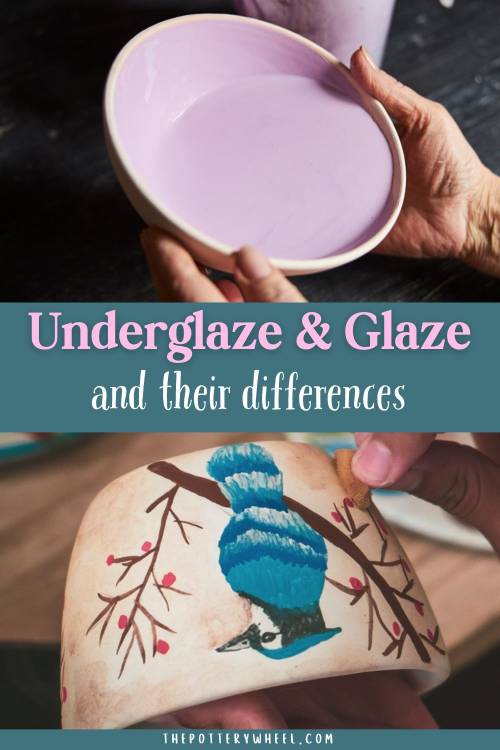Your cart is currently empty!
The Difference Between Underglaze and Glaze
Published:
Last Updated:
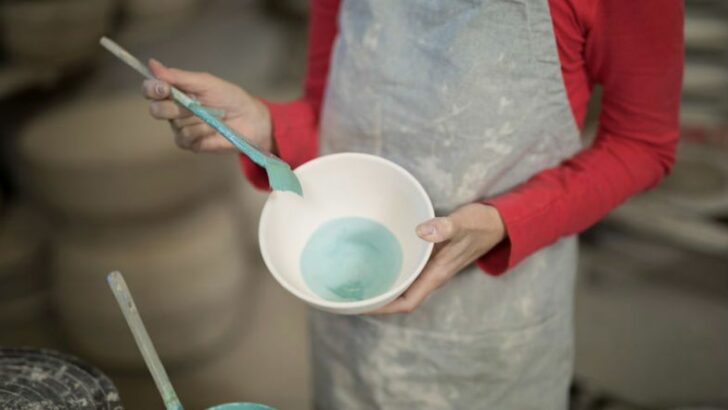
Affiliate Disclaimer
As an affiliate, we may earn a commission from qualifying purchases. We get commissions for purchases made through links on this website from Amazon and other third parties.
Two of the most common ways to decorate pottery are glaze and underglaze. These sound similar, but they aren’t the same. So, what is the difference between glaze and underglaze?
Glaze and underglaze are both used to decorate pottery. However, the main difference between underglaze and glaze is that underglaze is applied to the pottery and then a clear glaze is used on top to seal it. In contrast, glaze is often used on its own.
Let’s take a look at glaze and underglaze in turn to get a clear picture of the difference between the two.
What is Glaze?
Usually, pottery is fired in a kiln twice. A kiln is a large oven that heats clay to a high temperature. The term ‘firing’ refers to baking the clay in the kiln.
The first firing is called bisque firing, and it’s the time when the pottery turns from dry fragile clay to hard ceramic.
Liquid glaze is usually applied to bisque fired pottery. It is made up of a combination of oxides that are mixed up with water.
Here are some of the main ways that glaze is transferred onto the pottery…
- Painting
- Dipping
- Spraying
- Pouring
The liquid glaze dries on the surface of the bisque pottery and forms a dry powdery coating. This is then put in the kiln and fired a second time. During the second firing, the oxides in the glaze melt and form a liquid glass coat on the pottery.
When the kiln cools, the glassy coat turns solid and forms a hard layer that covers the pottery. The glaze coat looks nice, but it also forms a protective layer on the pottery, making it watertight and non-porous.
Pottery glaze is often used on its own as a way of decorating and sealing pottery.
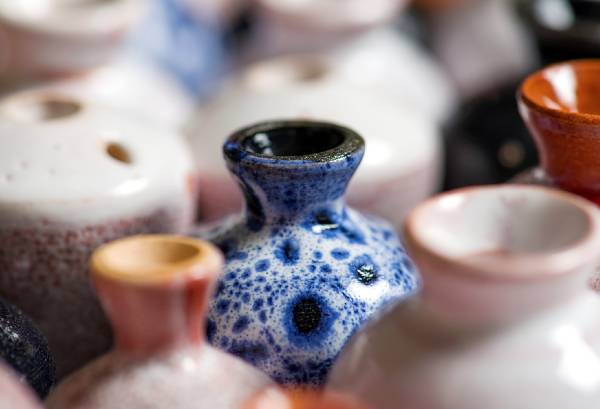
What is Underglaze?
Underglaze is also a way of decorating pottery, but usually, it isn’t used on its own. Normally, underglaze is applied to the pottery and then a protective layer of clear glaze is applied on top to seal the pottery. The clue is in the name, in that it’s usually used under glaze.
An easy way to remember the difference between pottery underglaze and glaze is to think of it a bit like paint and varnish. Underglaze is painted onto the pottery and then clear glaze is applied on top of the underglaze decoration.
Like glaze, underglaze can be applied to pottery in several ways, including the following…
- Painting
- Spraying
- Sponging
- Dabbing
- Dipping
- Pouring
- Drawing
- Airbrushing
You can get very creative when using underglaze and make intricate and detailed designs. If you want to know more about the different underglaze techniques you can read about that here.
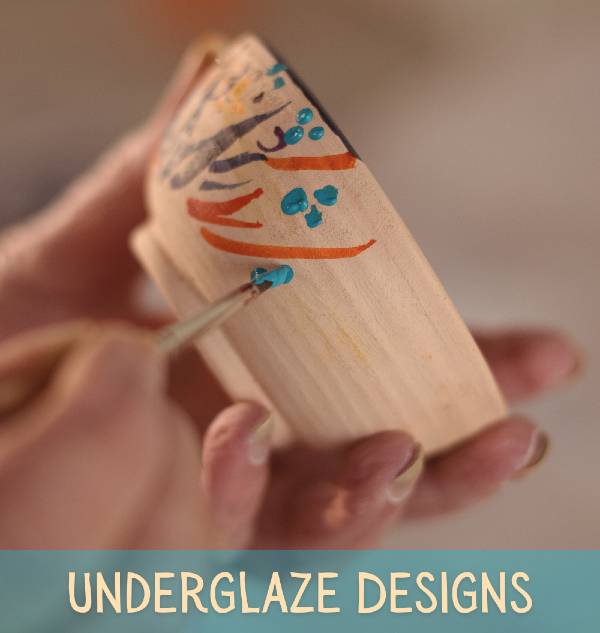
The Difference Between What Underglaze and Glaze Looks Like
Very often pottery glaze is applied to the whole of a piece of pottery except the base of the pot. The base isn’t glazed because it would stick to the kiln shelf when it was being fired.
There are lots of different types and styles of pottery glaze. Glaze comes in different colors and different finishes. Glazes can be glossy, matte, textured, smooth, solid colors, mixed colors, speckled, plain, transparent, or opaque. You can read more about the different types of pottery glaze you can use here.
Glaze is usually applied to the pottery as an even coat that is designed to cover the pot with a particular finish. Sometimes glazes that are compatible with each other are layered up to create a particular effect like a drippy glaze.
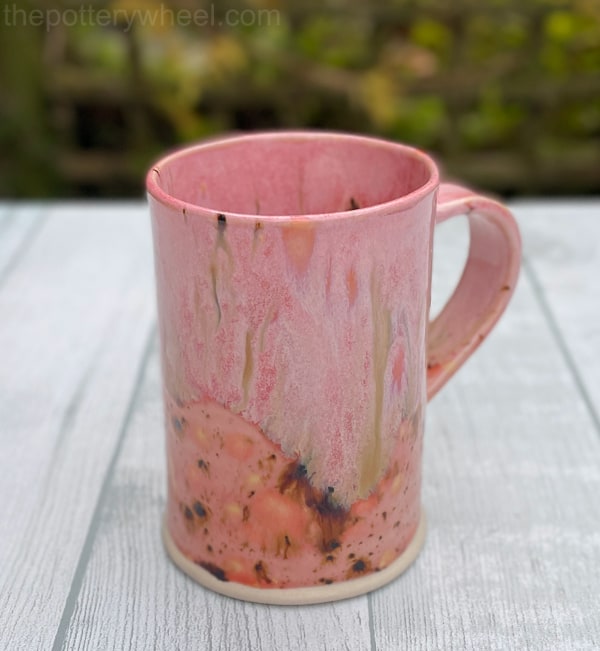
But even when glazes are layered, the finished glaze is one coating of a particular color, texture, or finish that covers the whole pot.
By contrast, underglaze can be used a bit more like regular artists paint to create detailed designs.
Part of the aim of pottery glaze is to create a sealed coat on the pot, so it is often applied over the whole surface of the pot except the bottom. But underglaze is all about decoration, so it can be used to paint parts of the pot and other bits can be left bare.
Different underglaze colors can be used to paint a picture or design on the pot much like painting on paper or canvas.
So, whilst pottery glaze creates broad designs that cover big areas of the pot, underglaze can be used to create detailed designs.
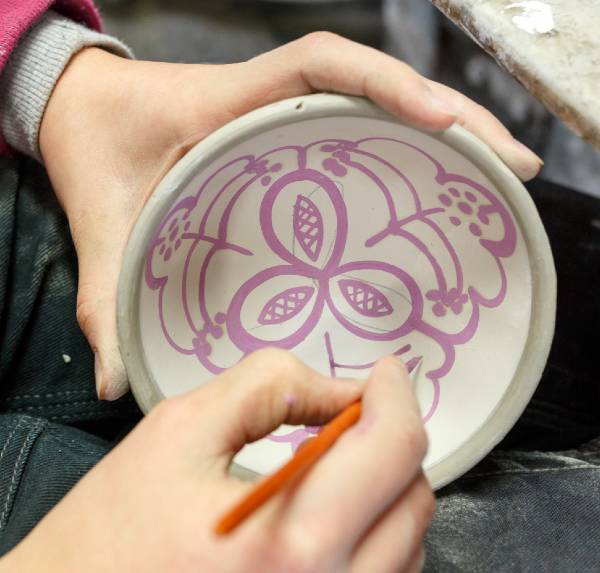
The Difference Between When Underglaze and Glaze Are Applied
Glaze is normally applied to pots that have been bisque fired. Pottery that has been through a bisque fire, is hard but porous.
When the glaze is applied to the ware, the water in the glaze is absorbed into the porous bisque surface. As the water is absorbed, a layer of the powdery glaze materials forms on the pottery.
Glaze is sometimes applied to greenware pottery. Greenware pottery is pots that haven’t been fired yet and are still in the stage of being raw clay. The pots are then fired in once and are converted from clay to glazed ware in one firing. This is sometimes called single firing or raw glazing.
One of the risks of raw glazing is that you can get glaze defects in your pottery. This is because during a regular bisque fire, moisture, gas, and fumes burn out of the clay.
If you don’t do a bisque fire, and apply the glaze directly to the greenware pottery, the gas and fumes from the clay can leave pinholes in the glaze surface.
So, whilst it’s possible to glaze greenware clay, it’s less risky to glaze bisque pottery. For that reason, most pottery glaze is applied to bisque.
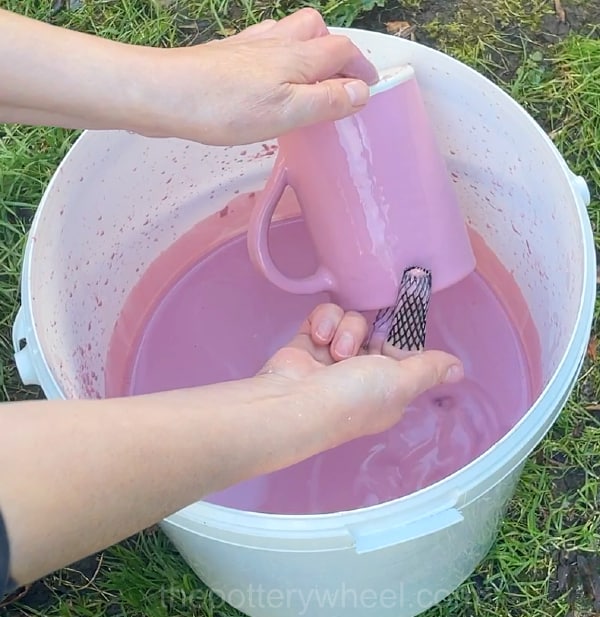
When is Underglaze Applied?
By contrast, underglaze can be used on both greenware and bisqueware. It can be used on pottery at any stage in the greenware process, including bone-dry clay.
Being able to apply ceramic underglaze to pottery at different stages can be helpful. Perhaps you underglaze your pottery and the bisque fire it only to find that the colors look a bit patchy or washed out.
The advantage of underglaze is that you can apply another coat of color after the bisque fire and touch up your decorations before you apply a clear glaze.
In fact, some potters bisque fire their pottery several times to build up layers of colored underglaze on their pots.
Underglaze has a particular combination of materials that give it its versatility. So, let’s take a look at those ingredients now…
The Difference Between What Glaze and Underglaze Are Made of
The basic ingredients of underglaze are water, clay, and pigments derived from oxides. It is because underglaze contains clay, it can be applied to unfired greenware pottery.
When clay dries it shrinks. Because underglaze contains clay, it also shrinks as the pot dries out. If the underglaze doesn’t shrink as much as the pottery, then it can flake off when the pot dries out.
The underglaze will stay attached to the surface of the pottery as long as they are shrinking at a similar rate.
What is Underglaze Made of?
In addition to water, clay, and colorants, underglaze often contains other ingredients that allow you to apply it to bisque ware. These extra ingredients are gum and sometimes frit. Here’s a little bit about both of these ingredients and how they help underglaze work.
Gum
Normally if a liquid contains clay and you paint it onto bisqueware the liquid will flake off as it dries out. This is because the clay shrinks as it dries out and the bisque ware does not shrink.
This is why it’s hard to paint bisque pottery with colored clay slip. The slip tends to flake off the bisque as it dries.
However, underglaze contains something called CMC gum. This is sometimes called ‘brushing gum’. Gum slows down the rate at which liquids dry, and it also makes them stickier.
The gum content in underglaze does a few things. Firstly, it stops the underglaze from drying out immediately when it makes contact with dry pottery. As a result, it is still spreadable on bone-dry clay and also on bisque ware. Secondly, it enables the underglaze to stick firmly to bisque, without cracking as it dries.
Frit
Originally underglazes were simply colored clay slips. However, more recently, underglazes have been made containing frit. Frit is a ceramic ground-up ceramic glass. When frit is fired in a kiln it melts, forming the liquid glass and making a glassy surface on the pot when it cools down.
If underglaze contains a lot of frit, then it starts working more like a glaze. For example, if it contains more frit than clay, it will melt like a glaze in the kiln. These types of underglaze can have a satin-like sheen when they are fired.
Here are some handy underglaze tips…
Tip 1: Some underglazes will flux and melt a bit like a pottery glaze. It’s a good idea to test your underglazes out. With some underglaze, you can paint the base of your pot and it won’t stick to the kiln shelf. But if the underglaze does contain a high amount of frit, it may melt a little when fired and stick to other surfaces.
Tip 2: If your underglaze does contain quite a bit of glass, it may be harder to glaze over once it’s fired. When underglaze is glassy, it isn’t as porous and it can stop glaze from sticking to the piece when it’s being applied.
Ingredients in Glaze
Glaze is made up of the following three basic ingredients:
- Glass-forming substances
- A stiffener
- Flux
The glass formers, such as silica or boron trioxide are what make the glaze glassy. A stiffener, like alumina, stops the glaze from sliding off the pot when it’s being fired. And the flux helps the glass formers melt at a lower temperature.
Other ingredients are added to recipes to give them their distinctive look, but these three components are the basic ones. Gum can also be added to glaze to make it more brushable.
The Difference in How Glaze and Underglaze are Used
You can apply glaze and underglaze to pottery using the same techniques of painting, dipping, spraying, and sponging. However, there are some differences.
With pottery glaze, you are often aiming to get an even coat of glaze on a large surface area. So, if you are painting your glaze, you will usually use a big soft brush that will cover a large area of the pot.
Often glaze is applied to pottery using something called a hake brush. These are big soft bristled brushes that you can load up with a lot of glaze. It’s then easier to float a large amount of glaze onto the pot surface in an even layer. Usually, it’s best to apply two or three coats of pottery glaze to get an even cover.
Whilst you can cover large areas of pottery with underglaze, it’s also possible to apply it with a very fine brush to paint details.
Underglaze can be used in a painterly way, to create pictures, scenes, or patterns on your pottery. Usually, underglaze is quite stable, so when it’s fired, it looks the same color as it did before it was fired. Also, underglaze tends to stay where it is when it is fired, so the colors won’t move or run.
By contrast, pottery glaze often looks completely different once it has been glazed. It may have a different color, texture, or opacity. Also, pottery glazes tend to move and melt into one another when they are fired, so it’s not possible to use them to paint detailed designs.
Overglazes and Enamels
One way that glaze can be used to create detailed and finer designs is the use of overglaze lusters and enamels.
These are special pigmented glazes that can be painted onto pottery that has already been glazed. For example, you might want to add fine gold or platinum details to your pottery using a gold luster.
This is then refired at a lower temperature to melt the gold luster onto the surface of the glaze. Gold luster and enamels can often look brown when they are applied, but become their true color when they are fired.
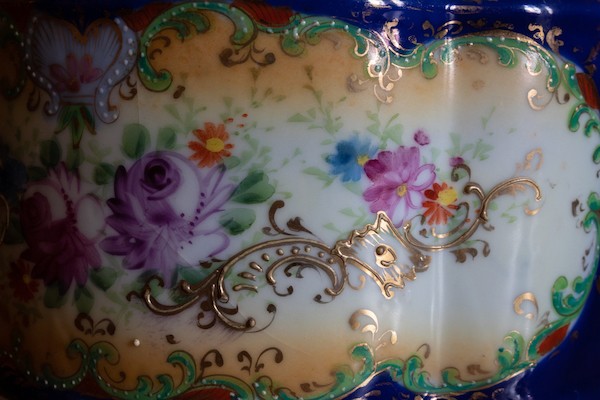
Applying Underglaze on Top of Glaze
Although underglaze is usually applied first and then covered by a clear glaze, there are other ways that it can be used. For example, there is a long tradition of using underglaze colors on top of a white base glaze. This technique was originally called maiolica and came to be known as majolica.
Traditionally pots were painted with a white tin oxide glaze. Before the pots were glaze fired, designs were painted directly onto the white glaze, using colored oxides suspended in water. Sometimes another clear lead glaze was applied on top of this to give the decoration a glossy finish.
The pot was then glaze fired to produce beautifully decorated pottery. You can read more about majolica and maiolica here.
Underglaze vs Glaze – Which is Best?
Glaze and underglaze ceramics both have their advantages and disadvantages. Here we take a look at glaze vs underglaze and some of the pros and cons of each.
The Pros and Cons of Underglaze
Pros
Cons
The Pros and Cons of Pottery Glaze
Pros
Cons
Final Thoughts
Ultimately, whether you prefer underglazing or glazing depends on personal preference and the look you are going for with your pots. I’ve noticed that potters who like painting on canvas often like painting with underglaze too. Personally, my painterly skills are limited! So, I prefer to work with glazes but like everything in pottery, it’s all open to experimentation. I’d suggest playing with those colors and seeing which one suits you best.
